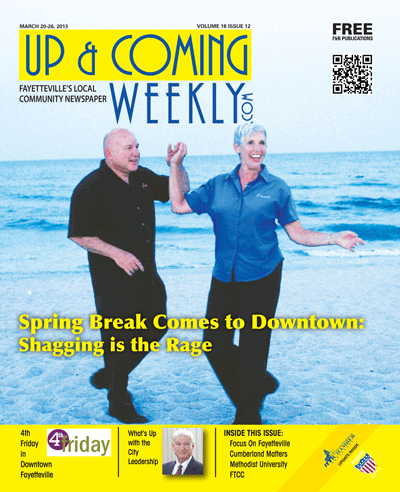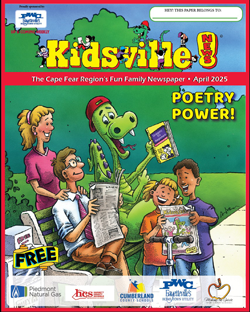 Spring Break is that magical marker in time that denotes the passing of winter and the promise of Spring. For thousands of college students that means an exodus to sunnier climes. For smaller children, it may mean a magical trip to Disney World or the first toes-in-the-sand visit to the beach. For those who work for a living, it usually passes without much notice — but not this year.
Spring Break is that magical marker in time that denotes the passing of winter and the promise of Spring. For thousands of college students that means an exodus to sunnier climes. For smaller children, it may mean a magical trip to Disney World or the first toes-in-the-sand visit to the beach. For those who work for a living, it usually passes without much notice — but not this year.
On March 29, supporters of The Cameo will bring Spring Break to downtown and you’re invited to kick off the work-week blues and join in the fun. Step back in time when dancing the Shag was all the rage, when the soles of your Weejuns were slick from so much time on the dance fl oor and the beach was always hopping.
The event, which is sponsored by Park View, Duggins & Smith Companies, Mellow Mushroom, Chuck Weber and Up & Coming Weekly, kicks off at 3 p.m. with Shag lessons and demonstrations at the Park View offices at 321 Hay St. Once you’ve figured out how to dance the Carolina’s favorite dance, slip out onto Hay Street for the Downtown Beach Crawl, which features beach bargains including everything from books and wine to beach music and art brought to you by Cape Fear Studios.
Also at 3 p.m., you can slip into the Cameo to view the iconic film tribute to the dance, Shag. The movie, which pretty much went straight to video, is a coming-of-age story of four Carolina girls who shrug off their responsibilities and head down to the forbidden land of Myrtle Beach to participate in the Ocean Drive Shag Contest. The film is fun and, if it doesn’t get your feet itching to dance or at least to cruise the strand, you have been working way too hard. A repeat of the fi lm will be shown at 7 p.m. at Gilbert Theater.
Following the movie, you may want to grab something to eat at one of your favorite downtown eateries before heading over the Metropolitan Room to dance the night away to the sounds of Classic Soul and the godfathers of Beach Music, The Embers. This event, which is being touted as a “Fun” raiser, will benefit the Cameo Art Theatre’s campaign to go digital. There will be a cash bar and pizza brought to you by Mellow Mushroom. Classic Soul will perform at 6 p.m. and at 7 p.m., The Embers will rock the house. The event is being emceed by beach music legend, King Curtis Carpenter, one of the founders of the CAMMY’S, North Carolina’s own Beach Music Awards Show.
If you are not from the Carolinas, you might be wondering about this thing called the Shag, well here’s is a brief primer for you.
“Beach Music is Coming to Town” is a headline you couldn’t see in the 1950s and early 1960s, even though Beach Music was all around. Fas’ dancers in the Carolinas were steppin’ to this music at the coasts, a few dozen inland armories, lakeside dance slabs, and other widespread pavilions. But it didn’t have a name.
In 1965 Beach Music silently celebrated its 20th birthday. There still wasn’t a universal name which everyone understood, it had just blossomed. Jack Stallings, one of the early Catalinas from Charlotte remembered a party they played in Conway that summer. Several times that day, a few of the kids requested some ‘beach music.’ Jack fi nally asked what they were talking about.
“You know, those songs you can hear down at the beach,” they named a few by the Impressions, Four Tops, and Drifters. Jack thought, ‘oh, rhythm and blues, we play that stuff all the time.’
Two years earlier, Dillon County musician Rufus Oates took the first steps of his dream to open a music store to sell all kinds of instruments to school bands and musicians like himself (if it had strings, Rufus could play it — bass, mandolin, guitar, banjo, fiddle). Rufus opened his Music Center in September 1963 back at the beach where he’d wanted to return since he and his wife lived in Conway a few years earlier before moving to Tarboro, NC. The dream was on with his new Beach Music Center in downtown Myrtle Beach.
Funny thing about that name … right away folks saw the sign, went in and asked if he had “Sixty Minute Man,” “One Mint Julep” or “Green Eyes.” Ever the capitalist, Rufus said he’d be getting them in pretty soon. That was the beginning of the section of his store which became the (*Beach Music* Center) inside the Beach *Music Center.*
It took two or three years for the word to spread about the new ‘Beach Music’ store in Myrtle Beach. Apparently the term ‘Beach Music’ automatically made sense to people who had experienced the R&B heard almost exclusively on the Pavilion jukeboxes up and down the coast.
Beach Music is a phrase that describes more than one phenomenon. It’s the convergence of at least three infl uences.
There was the unnamed music which Shaggers and Boppers (or Fas’ dancers and Basic dancers) danced to from 1945-1965. A tiny percentage of those songs were retroactively named Beach Music.
Local combos began to appear on college campuses before Rufus’ store opened: Gladiolas at Limestone College 1957, Clemson 1958, USC Chapel Hill 1958; Catalinas at Charlotte College 1958; Jetty Jumpers at Wilmington College 1959; Hot Nuts at UNC Chapel Hill 1959; 1961-1965 Plaids, Weejuns, Madras, Turk-Cords, Bob Collins and the Fabulous 5, Embers and a few others were playing the campuses, but they still weren’t *Beach Music* … The term wasn’t universal beyond the Beach and Conway. The fi rst documented mention of “Beach Music” we’ve found beyond the beach is in a May 1967 issue of the Robesonian in Lumberton, NC.
Some bands played as early as 1960 and 1961 at the Magic Attic upstairs in the Myrtle Beach pavilion. Bands played at Folly Beach pavilion in the early 60s, the fourth Pawley’s Pavilion from 1960 onward, Atlantic Beach, North Carolina, and a number of other bandstands throughout the region. People showed up to Shag and Bop, but it still wasn’t called Beach Music until after the mid-point of the 60s.
Randy Rowland of Statesville co-owned Groucho’s, one of the premier Shag clubs in Charlotte from the 70s to the 90s. Not surprisingly, he left a good, full-time job to be close to the music and dance he loved.
Rowland also has one of those memories that are a researcher’s dream.
The first three records he heard on his family’s vacation together there in 1959 were “Almost Grown” by Chuck Berry, “…some of them were half-timing to it and some of the jitterbugs were trying to dance to it straight up [at its natural tempo],” Rowland remembers. The other two songs were “There Goes My Baby” by the Drifters and Lloyd Price’s “Stagger Lee.”
Occasionally, Rowland and a friend visited Kostakes Music in the NoDa district of North Charlotte. Kostakes was a jukebox and music distributor who sold used records in ‘grab bag’ boxes of 125 for $40. “We’d take those boxes home and look for treasures, Billy Stewart, Marvin Gaye, the Four Tops, and the Temptations to name a few,” Rowland went on. “We called it ‘soul’ music.”
After Larry Pressley’s Cellar opened in 1965, Rowland and friends attended Wednesday nights to hear the Embers and dance to the music, but it still had no name.
“We danced to it at Grace Park Recreation Center and George’s in Statesville, but I never heard it called ‘Beach Music.’ That was still true at the big 1967 dance contest Jimmy Kilgo of TV 9’s Kilgo’s Canteen at the National Guard Armory in Statesville. Kilgo had Maurice Williams and the Zodiacs set up at one end of the building and the Catalinas at the other. They’d alternate, playing the music we loved, but it didn’t have a name.”
Randy first heard the term “Beach Music” in the Army in 1968.
“One of the first guys I met was Durwood Martin. We used to talk about the music that we listened and danced to back home, the music Durwood’s band played. Durwood was an early member of the Embers. Once in a while someone would say, ‘yeah, I miss that good old Beach Music back home.’”
We asked Randy how he thought that ‘Beach Music’ might have retroactively annexed songs from earlier years and moved them under the 60s’ umbrella term Beach Music?
“The first record I bought was ‘I’ll Be Satisfi ed’ by Jackie Wilson in 1959. I’ve loved that song ever since. Funny thing is, most of the records on the jukebox at Sonny’s Pavilion on the Cherry Grove section of Ocean Drive, S.C., were still on the jukebox in 1966. They switched them out from time to time for some others, but the same records were being rotated.”
Shag and Beach Music ended up in Panama City, Florida in 1953 as a direct, personal import by a young girl and two guy-friends who traveled to Ocean Drive just to learn the Shag. By the time they got home they’d turned the ‘basic’ dance around. The dance became known as the P.C. Bop. Bop music dove deep to find the right beat in Gulf Coast rhythm and blues and blues.
In the Beach Music Guide Volumes 1 and 2 it is documented that the first Black music on jukeboxes in white venues showed up in 1945 simultaneously at Carolina Beach, Minnesott Beach, and Oriental Beach. It wasn’t by committee or telephone conference, it just happened.

 How to resolve AdBlock issue?
How to resolve AdBlock issue? 








